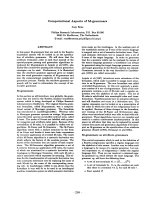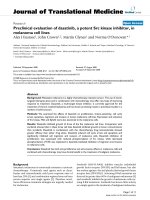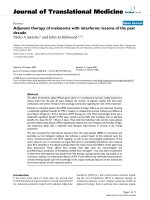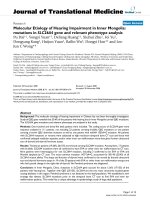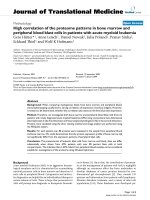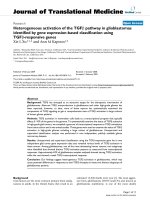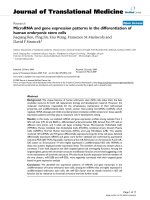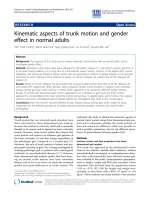Báo cáo hóa học: " Critical aspects of substrate nanopatterning for the ordered growth of GaN nanocolumns" potx
Bạn đang xem bản rút gọn của tài liệu. Xem và tải ngay bản đầy đủ của tài liệu tại đây (1.13 MB, 9 trang )
NANO EXPRESS Open Access
Critical aspects of substrate nanopatterning for
the ordered growth of GaN nanocolumns
Francesca Barbagini
1*†
, Ana Bengoechea-Encabo
1†
, Steven Albert
1†
, Javier Martinez
1†
,
Miguel Angel Sanchez García
1†
, Achim Trampert
2†
and Enrique Calleja
1†
Abstract
Precise and reproducible surface nanopatterning is the key for a successful ordered growth of GaN nanocolumns.
In this work, we point out the main technological issues related to the patterning process, mainly surface
roughness and cleaning, and mask adhesion to the substrate. We found that each of these factors, process-related,
has a dramatic impact on the subsequent selective growth of the columns inside the patterned holes. We
compare the performance of e-beam lithography, colloidal lithography, and focused ion beam in the fabrication of
hole-patterned masks for ordered columnar growth. Th ese results are applicable to the ordered growth of
nanocolumns of different materials.
Keywords: GaN nanocolumns, ordered growth, molecular beam epitaxy, surface cleaning, roughness, adhesion, e-
beam lithography, colloidal lithography, focused ion beam
Background
The unique properties of III-nitride nanocolumns [NCs]
in contrast to thin film structures derive from the
reduced footprint on the substrate that enables essen-
tially dislocation- and strain- free growth on a variety of
substrates [1]. Defect -free NCs exhibi t excell ent electro-
nic transport a nd optical properties for the fabrication
of high-efficiency optoelectronic nanodevices, such as
photodetectors, light-emitting diodes, and solar cells
[2-5]. Moreover, the controlled coalescence of III-nitride
NCs would lead to strain-free pseudosubstrates with
reduced defect densities [6].
During the past years, III-nitride NCs have been
grown in the self-assembled mode by plasma-assisted
molecular beam epitaxy [PA-MBE] [7-9] on various sub-
strates. However, fluctuations in density and dimensions
of the NCs lead to significant dispersion in the optoelec-
tronic properties and render the device processing very
difficult. Thus, the realization of true devices relies on
the achievement of ordered arrays of homogeneous NCs
by localiza tion of the epitaxial growth on predetermined
preferential sites. This growth mode is known as selec-
tive area growth [SAG], and it has attracted much scien-
tific interest in the last few years [10-15].
In the SAG, the substrate is pre-patterned with a mask
of nanoholes. The NCs nucleate and grow selectively
inside the nanoholes and not on the surface of the
mask. Many experimental works have been reported on
the SAG of GaN/InGaN nanocolumnar heterostructures
[10-14]. In these works, the hole patterning of the mask
material was achieved either by focused ion beam [FIB]
or by e-beam lithography [EBL]. However, despite the
fundamental importance of the nanopatterning pro cess,
no detailed information has been reported neither on
the choice of the particular nanopatterning technique
nor on the importance of the m orphology of the pat-
terned mask with respect to the subsequent selective
growth. Within this context, the quality of the surface
pattern is crucial because it determines whether selectiv-
ity is achieved or not.
This work studies the hole patterning of the mask
material for the subsequent SAG of GaN NCs by PA-
MBE . Three different techniques are reported that were
successfully used to pre-pattern the surface of a thin Ti
mask with ordered arrays of nanoholes: EBL followed by
dry etch, colloidal lithography [CL], and FIB. The critical
issues encountered in the mask fabrication processes are
* Correspondence:
† Contributed equally
1
ISOM and Electrical Engineering Dept. (DIE), Escuela Técnica Superior de
Ingenieros de Telecomunicaciónes (ETSIT), Universidad Politécnica de Madrid
s/n, Madrid, 28040, Spain
Full list of author information is available at the end of the article
Barbagini et al. Nanoscale Research Letters 2011, 6:632
/>© 2011 Barbagini et al; licensee Springer. This is an Open Access ar ticle distributed under the terms of the Creative Commons
Attribution License (http://crea tivecommons.org/licenses/by/2.0), which pe rmits unrestricted use, distribution, and re prod uction in
any medium, provide d the origin al work is properly cited.
studied in detail. More specifically, the effects of surface
roughness, adhesion of the mask layer to the substrate,
and surface cleanliness on the follo wing GaN NCs SAG
are analyzed. For each of the mentioned techniques, the
main advantages and d rawbacks are highlighted. Only
when the patterning process was optimized, high-quality
hole-patterned masks of different dimensions and geo-
metry were obtained. These masks were sub sequently
used to grow ordered crystalline GaN NCs in the SAG
mode by PA-MBE. The technological issues discussed in
this work can be applied to the ordered growth of any
kind of material on various substrates.
Methods
Substrate nanopatterning
All substrates used in this work were commercial 2-in.
wafers consisting of a 4-μm GaN (0001) layer grown on
sapphire by MOVPE (Lumilog, Les Moulins, Vallauris,
France). These substrates were cleaned in N-methyl-pyr-
rolidone [NMP] at 90°C for 30 min, rinsed in isopropa-
nol [IPA], and thoroughly cleared with deionized [DI]
water. The mask material always consisted of a 5- to 10-
nm Ti layer deposited on a clean GaN template by e-
beam evaporation. The root mean square [RMS] rough-
ness of the wafer surface before and after Ti deposition
was 0.4 ± 0.1 nm in an area of 1 μm
2
. The various tech-
niques used to pattern the Ti mask with ordered arrays
of nanoholes are described in detail in the following
subparagraphs. Prior to each PA-MBE growth, the dis-
tribution, diameter, and depth of the nanoholes were
characteri zed by atomic force miscroscopy [AFM]
(Nanoscope III Multimode AFM, Veeco Instruments
Inc., Plainview, NY, USA) and scanning electron micro-
scopy [SEM] (CABL-9500C, Crestec Co. Ltd., Hama-
matsu, Shizuoka, Japan).
E-beam lithography
A 350-nm layer of positive resist ZEP520A (Zeon Co.,
Tokyo, Japan) was spun at 4,000 rpm on the Ti mask.
After baking at 190°C for 2 min, the sample was trans-
ferred to the EBL system. The nanoholes were opened
in the resist using a current of 0.5 × 10
-9
A, and an
exposure time ranging from 15 to 45 μs. The process
conditions were optimized to obtain arrays of nanoholes
with diameters ranging from 50 to 200 nm and pitch
(center-to-center distance) varying from 80 nm to 300
nm. After developing the resist, the sample was dry-
etched in O
2
/CF
4
plasma at 10
-2
mbar and 110 W (Plas-
malab, Oxford Instruments plc, Abingdon, Oxfordshire,
UK) for 130 s. The post-etch residue was removed by
immersing in NMP at 80°C for 30 min and abundantly
rinsing in IPA and DI water. In some cases, oxygen
plasma was necessary to completely remove the resist
hardened by the previous plasma etching. AFM analysis
revealed an etching depth between 7 and 10 nm; thus,
the GaN material underneath the Ti mask was also
etched some 2 to 5 nm.
Colloidal lithography
Thi s method was extensively introduced elsewhere [16].
Briefly, the GaN substrate was made negatively charged
by coating with a trilayer of polyelectrolytes. Monodis-
persed sulfate latex spheres (mean diameter of 260 nm;
Invitrogen, Carlsbad, CA, USA) were spun on GaN from
aqueous solutions to obtain a densely packed monolayer
of nanosphe res. Subsequent oxyg en pl asma was used to
reduce the sphere dimensions thus creating some
sphere -to-sphere interspace. A 5- to 10-nm Ti layer was
evaporated on top, and the spheres were finally stripped
from the sample using an adhesive pad. The final clean-
ing step co nsisted of using NMP at 90°C to dissolve any
latex residue from the nanoparticles and thoroughly rin-
sing with DI water.
Focused ion beam
The nanoholes were opened in the 7-nm Ti mask on
GaN by a focused ion beam in a one-step process. The
liquid-metal ion source used was Ga
+
at 30 KeV (ion-
Line Raith GmbH, Dortmund, Germany). The process
conditions were optimized to obtain arrays of nanoholes
with a 100-nm diameter and 250-nm pitch (30 pA, ion
dose 10
17
cm
-2
). No extra cleaning steps were applied
after the ion etching. AFM analysis revealed an etching
depth between 10 and 15 nm. Little redeposition of Ti
(1 to 2 nm) appears in some cases at the edges of the
holes.
Ordered nanocolumnar growth
GaN NCs were grown on the ho le-patterned masks
using radio frequency [RF] PA-MBE (Compact 21,
Riber, USA). Th e substrate temperature during growth
was measured with a thermocouple located at the
growthstage.TheGaandNfluxeswerecalibratedin
equivalent (0001) GaN growth rate units for compact
layers in nanometers per minute, which are the standard
units used in nitride PA-MBE growth diagrams. The Ti
mask was nitrided prior to growth to prevent its degra-
dation due to the high temperatures used in GaN NCs
SAG (860°C to 900°C). We used a two-step nitridation
process, as proposed by Sekiguchi et al. [10,11]: 10 min
at 460°C followed by 3 min at 880°C. During nitridation,
the plasma power was set to 580 W and the nitrogen
flux, to 1.2 sccm. These conditions correspond to an
equivalent stoichiometric GaN growth rate higher than
30 nm/min. Electron energy loss spectroscopy measure-
ments proved t he formation of TiN, which is more
stable than Ti at high temperatures. During the growth
phase, we lowered the plasma power and the nitrogen
flux to 150 W and 0.3 sccm, respectively. The GaN flux
is maintained at a corresponding GaN growth rate of 16
nm/min. These conditions resulted in a highly selective
Barbagini et al. Nanoscale Research Letters 2011, 6:632
/>Page 2 of 9
ordered growth inside the nanoholes, as widely illu-
strated in a previous publication [13].
Results and discussion
The mask f abrication process consists of many critical
steps that, in the worst case scenario, might lead to the
total failure of the selective growth. The factors to
account for can be basically summarized into surface
roughness, surface cleaning, and adhesion of the mask
material to the substrate. Each of them is treated sepa-
rately in the following subparagraphs.
Surface roughness
Figure 1 shows the case of a smooth EBL mask surface
(Figure 1a), the case o f an EBL mask with local increase
in roughness in the 20-nm region around the holes’ rim
(Figure 1b), and the case of a FIB mask with b umps in
the 20-nm region around the holes’ rim (Figure 1c). In
the case of Figure 1a, the surface roughness of the mask
as measured by AFM is 0.5 ± 0.1 nm, which is similar
to the RMS values of both the bare GaN template and
the as-deposited Ti l ayer. These roughness values lead
to PA-MBE growth with a perfect (100%) selective
nucleation of NCs inside the holes (Figure 1d ). On the
contrary, accurate AFM analysis of the masks in Figure
1b, c revealed the presence of material around the holes’
rim that locally increased the surface roughness by 1
nm or higher. In the case of EBL masks (Figure 1b), this
particular morphology is attributed to the redeposition
of etched material around the holes during the plasma
etch, whereas surface bumps around the holes in FIB
masks are probably formed when bombarding the Ti
(c)
(f)
(a)
(d)
(b)
(e)
Figure 1 Influence of surface roughness on the selective columnar growth. Top row: typical example of (a) an ideal smooth mask obtained
by EBL, ( b) masks with increased roughness in the area around the holes obtained by EBL, and (c) a FIB mask with bumps around the holes.
Insets: cross-section AFM analysis of the nanoholes. Bottom row: growth results using the respective masks in the upper row. (d) With an ideal
smooth mask, perfect ordered growth is achieved; in the case of local higher roughness around the holes, typical donut-shaped growth is
observed from the (e) top view and (f) side view SEM images.
Barbagini et al. Nanoscale Research Letters 2011, 6:632
/>Page 3 of 9
with a high Ga dose. Both these cases resulted in a typi-
cal donut-shaped growth, where many thin NCs nucle-
ate around the holes’ rim leaving the holes core empty,
as shown in Figure 1e, f. In about 50% of the cases, sin-
gle tubular NCs were observed, as shown in Figure 1f. It
wasdemonstrated[17]thatsurfacemigrationofad-
atoms is the main contribution for selective growth
when using Ti masks. This peculiar growth layout is
thus likely due to the difficulty for the Ga and N ad-
atoms to diffuse from the surface into the holes due to
either the deposited material or bumps that act as diffu-
sion barriers. For this reason, the NCs nucleate at the
perimeter of the donut-shaped bumps. The p resence of
accumulated material around the holes can only be
detected by accurate AFM analysis, while SEM pictures
show smooth surfaces even when there is local increase
in RMS. To minimize this material redeposition and
achieve optimal roughness conditions, we optimized
both the plasma etch in EBL technique (mainly plasma
power and time) and the dose in the FIB. In particular,
the EBL and etch processes were optimized using three
series of samples. First, the EBL dose was varied until
finding the minimum dose required to open sufficiently
wide holes that subsequently enabled to completely etch
the Ti layer underneath. In the second series of samples,
we thus used this optimal EBL conditions and increased
the RF pow er during etch, until the materia l redeposi-
tion around the holes was minimized. In the last series
of samples, we maintained constant EBL condit ions and
RF power during the etching while slightly reducing the
etching time in order to le ave the surf ace roughness as
low as possible and ensuring to etc h the complete Ti
layer and 1-2 nm of the underneath GaN material. SEM
and AFM studies of the holes geometry and of the sur-
face roughness were measured at the end of the com-
plete processing for each series of samples. For the FIB
optimization, several dose studies were necessary in
order to obtain the best conditions to pattern holes with
a depth of 7 nm. An array of holes with similar diameter
(100 nm) but different doses was patterned on a small
piece of Ti (7-nm thickness) on GaN. After the pattern-
ing, the depth of the nanoholes and the surface rough-
ness of the Ti were measured by AFM. The hole with
the right depth and no bumps at the surface was consid-
ered as the optimal dose for the FIB. In our case, the
optimal ion dose was 10
17
cm
-2
. The surface roughness
was never an issue when preparing the masks by CL
since there was no etching involved.
Surface cleaning of the hole-patterned mask
When the surface of the patterned mask present resist
residues, a s shown in Figure 2a, c (SEM and AFM,
respectively), GaN NCs still nucleate inside the holes
and exhibit constant distribution, height, and diameter.
However, in the spots where the resist residues lie, thin-
ner NCs nucleate on the mask and grow faster than the
ordered ones inside the holes. These growth results are
displayed in Figure 2b, d (top view a nd side view,
respectively). In principle , organic contaminants, includ-
ing resist residues, should evaporate during the nitrida-
tion at high temperature. However, similar growth
features were always observed when some resist residues
were present on the mask before the growth. In addition
to this, we highlight in general on the detrimental effect
of organic contamination on the subsequent growth.
This point sounds trivial, though it is not always
straightfor ward to identify resi st residues over the mask
or inside the holes, due to the high aspect ratio of the
patterns and to the finite dimensions of the AFM tip. In
50% of the cases, neither SEM nor AFM analysis of the
patterned mask showed any surface contamination
before the growth. However, from the growth results,
we deduced that contamination occurred at some point
during the mask fabrication. When organic contamina-
tion occurred inside the holes only, non-uniform growth
was observed, where the contaminated holes exhibited
no nucleation at all.
Surface cleaning is thus a key point to consider in any
method of mask preparation. However, the plasma-har-
dened photoresist is very difficult to remove compared
to common organic contaminants. For this reason, the
issue of s urface cleaning becomes even more important
when preparing the masks by EBL. The optimal cleaning
process for EBL masks before loading the sample in the
PA-MBE chamber consisted of 30 min immersion in
pyrrolidone at 80°C followed by a hot isopropanol rinse
and abundant hot water rinse. Finally, a 15-s oxygen
plasma was performed.
Adhesion of the Ti mask to the substrate
A thick Ti la yer barely adhered to the GaN substrate
material resulted in delamination of the mask during
the MBE growth, as shown in Figure 3a. This delamina-
tion was observed when the PA-MBE growth stage
cooled down after growth from 650°C to 700°C, to room
temperature. This issue was solved by optimizing both
the adhesion of the Ti film to the substrate and the
thickness of the Ti film. To improve adhesion, the initial
GaN template (as received) was cleaned with NMP at
90° by sweeping the surface several times with a soft
stick, then abundantly rinsing with IPA and DIW. Prior
to Ti deposition, the substrate was heated up in an oven
at 300°C for 30 min to desorb water molecules from the
surface. The optimal thickness of the Ti layer was found
empirically. Since the mask adhesion was optimized,
delamination was probably due to the strain generated
by thermal shock when cooling down the system. To
decrease the amount of strain, the thickness of the Ti
Barbagini et al. Nanoscale Research Letters 2011, 6:632
/>Page 4 of 9
mask was reduced from 10 nm to 7 nm. A thinner mask
resulted in most cases in the complete degradation of
the Ti material at high temperature during the growth,
as shown in Figure 3b. Mask adhesion to the s ubstrate
is a factor to consider in all of the proposed methods,
meaning EBL, FIB, and CL. Both optimal substrate
cleaning and mask thickness are of fundamental impor-
tance for a good adhesion of the Ti layer to the
substrate.
Despite all these technical issues, high-quality nano-
patterned masks were successfully fabricated using all of
the three techniques by optimizing the process para-
meters. Typical examples of hole-patterned Ti masks as
obtained by EBL, CL, and FIB are shown in Figure 4a, c,
e, respectively. In all cases, the diameter of the holes
varies between 50 nm and 250 nm, and the pitch,
between 80 nm and 350 nm. Using these masks, selec-
tive nucleation and growth of GaN NCs inside the holes
were achieved by PA-MBE, independent of t he charac-
teristic mask dimensions (within the above mentioned
range) and of the particular patterning technique. These
growth results are shown in Figure 4b, d, f for each of
the respective masks. Ordered GaN NCs always exhib-
ited a constant diameter and interdistance that fit to the
geometry of the initial patterned mask, meaning that the
vertical growth rate was much higher than t he lateral
one. After 30 min of growth, all the GaN NCs have a
constant height of about 200 nm and show a perfect
Figure 2 Effect of surface cleaning on the columnar growth. Left side: (a)SEMand(c) AFM images of a nanopattern ed Ti mask with resist
residues (whiter spots). Right side: (b) top view and (d) side view SEM images of GaN NCs grown by PA-MBE using these masks, showing
ordered columns grown inside the holes and thinner and longer columns grown in the area between the holes on the Ti mask.
Barbagini et al. Nanoscale Research Letters 2011, 6:632
/>Page 5 of 9
hexagonal cross section. The latter can be better appre-
ciated in Figure 1d, which shows a top view of the
ordered NCs. High ordering and constant geometrical
paramet ers (pitch, diameter) were easily achieved in the
case of both EBL and FIB. In the case of colloidal litho-
graphy, however, we stress on the extraordinary level of
ordering and homogeneity in the diameter of the holes
and pitch over large areas of several microns, despite
the simplicity o f the process. Only localized areas show
little defects such as a larger hole or a missed hole.
These defects are due to agglomeration of particles dur-
ing deposition or to a missed particle in the initial nano-
sphere monolayer.
Figure 5a, b shows the TEM analysis of a single GaN
NC. In particular, Figure 5b is a magnification at the NC/
GaN template/Ti interface. The diffraction contrast image,
which is sensitive to crystal defects, exhibits dark contrast
lines that give evidence for the presence of stacking faults
at the NC/GaN template interface. However, it is clearly
shown that the stacking faults cross the whole rod and do
not lead to the formation of partial dislocations. The small
foot print and the large surface area (high aspect ratio) of
NCs are known to induce strain-free growth. Initial dislo-
cations, either from the substrate or generated during the
nucleation stage, bend to the lateral surface [1,2]. More-
over, the initial GaN template consisted of a 4-μm strain-
free GaN layer on sapphire, and the NCs growth is homo-
epitaxial. For all the mentioned reasons, we conclude that
there is no epitaxial strain involved. The presence of stack-
ing faults at the bottom of the NCs could be attributed to
impurities, such as Ti.
From these results, it becomes evident that high-preci-
sion ordering of GaN NCs can easily be achieved by
either EBL or FIB techniques. The main disadvantage of
the EBL technique is the need for etching and the
organic-cleaning steps. Both these steps, when not opti-
mized, increase the surface roughness and/or the level
of surface contamination, leading to a total failure of the
selective growth. In contrast, FIB and CL techniques
require neither the etch step nor a strong post-proces-
sing surface cleaning. However, the FIB process must be
optimized to prevent the formation of bumps around
the holes that block the surface diffusion of ad-atoms
and hence the SAG. Finally, CL enables to obtain large
patterned areas using a low-cost, fast processing. The
main drawback of this technique is the lack of a precise
predefined ordered patterning.
Conclusions
Optimized EBL, FIB, and CL processes were used to
fabricate high-quality masks patterned with nanoholes,
which served as nucleation sites for the selective area
growth of G aN NCs. Once the process window for the
ordered growth of GaN NCs by PA-MBE was identified,
the successful selective growth was driven by the mor-
phology of the hole-patterned Ti mask. Surface rough-
ness and cleaning, and adhesion of the Ti mask to the
GaN substrate are the most critical aspects that might
negatively influence the ordered growth. In this context,
our results suggest that FIB and CL, where neither etch-
ing steps nor organic chemicals are introduced, are pre-
ferred techniques to fabricate high-quality and
(a)
(b)
Figure 3 Effect of titanium mask quality on the columnar growth.(a) Peeling-off of a 10-nm thick Ti mask after PA-MBE growth. (b)
Degradation of a 5-nm thick Ti mask during nitridation at high temperature in the PA-MBE chamber.
Barbagini et al. Nanoscale Research Letters 2011, 6:632
/>Page 6 of 9
reproducible hole-patterned masks. CL in particular is
easy and fast compared to any other method. However,
it lacks a predefined high-precision mask layout. FIB
might present the issue of material redeposition around
the patterns. Although this paper focuses on GaN nano-
columns , these technological aspects can be extended to
the selective growth of nanostructures of different mate-
rial and geometries.
(a)
(b)
(c)
(d)
(e)
(f)
Figure 4 High quality nanopatterned masks resulting in ordered columnar growth. Left side: ordered arrays of nanoholes on Ti masks on
GaN template, obtained by (a) EBL, (c) CL, and (e) FIB. Right side: typical results (b, d, and f) of the selective area growth of GaN NCs by PA-MBE
on each of the respective masks.
Barbagini et al. Nanoscale Research Letters 2011, 6:632
/>Page 7 of 9
Abbreviations
AFM: atomic force microscopy; CL: colloidal lithography; DI: deionized; EBL:
electronic beam lithography; FIB: focused ion beam; IPA: isopropanol: NCs:
nanocolumns; NMP: normal-methyl-pyrrolidone; PA-MBE: plasma-assisted
molecular beam epitaxy; RF: radio frequency; SAG: selective area growth:
SEM: scanning electron microscopy; TEM: transmission electron microscopy.
Acknowledgements
This research was supported by a Marie Curie Intra European Fellowship
within the 7th European Community Framework, PIEF-GA-2009-253085 ,
national projects CAM P2009/ESP-1503, MICINN-PLE2009-0023, MICINN-MAT-
2008- 04815, and by the UE CP-IP 228999-2 (SMASH) project.
Author details
1
ISOM and Electrical Engineering Dept. (DIE), Escuela Técnica Superior de
Ingenieros de Telecomunicaciónes (ETSIT), Universidad Politécnica de Madrid
s/n, Madrid, 28040, Spain
2
Paul Drude Institut für Festköperelektronik,
Hausvogteiplatz 5-7, Berlin, 10117, Germany
Authors’ contributions
FB performed the substrate nanopatterning by e-beam lithography. ABE and
SA carried out the PA-MBE growths. JM provided the mask patterned by FIB.
MASG supervised the PA-MBE growth. EC supervised the whole work as the
principal scientist. AT performed the TEM analysis. All authors read and
approved the final manuscript.
Competing interests
The authors declare that they have no competing interests.
Received: 24 August 2011 Accepted: 14 December 2011
Published: 14 December 2011
References
1. Calleja E, Ristić J, Fernández-Garrido S, Cerutti L, Sánchez-García MA,
Grandal J, Trampert A, Jahn U, Sánchez G, Griol A, Sánchez B: Growth,
morphology, and structural properties of group-III-nitride nanocolumns
and nanodisks. Phys Stat Sol (b) 2007, 244:2816-2837.
2. Ristić J, Calleja E, Trampert A, Fernández-Garrido S, Rivera C, Jahn U,
Ploog KH: Columnar AlGaN/GaN nanocavities with AlN/GaN bragg
reflectors grown by molecular beam epitaxy on Si(111). Phys Rev Lett
2005, 94:146102-146106.
3. Guo W, Zhang M, Banerjee A, Bhattacharya P: Auger recombination in III-
nitride nanowires and its effect on nanowire light-emitting diode
characteristics. Nano Letters 2011, 11:1434-1438.
4. Sekiguchi H, Kishino K, Kikuchi A: Emission color control from blue to red
with nanocolumn diameter of InGaN/GaN nanocolumn arrays grown on
same substrate. Appl Phys Lett 2010, 96:231104-231107.
5. Heon-Jin C, Johnson JC, He R, Lee SK, Kim F, Pauzauskie P, Goldberger J,
Saykally RJ, Yang P: Self-organized GaN quantum wire UV lasers. J Phys
Chem B 2003, 107:8721-8725.
6. Bougrioua Z, Gibart P, Calleja E, Jahn U, Trampert A, Ristic J, Utrera M,
Nataf G: Growth of freestanding GaN using pillar-epitaxial lateral
overgrowth from GaN nanocolumns. J Crystal Growth 2007, 309:113-120.
7. Fernandéz-Garrido S, Grandal J, Calleja E, Sánchez-García MA, López-
Romero D: A growth diagram for plasma-assisted molecular beam
epitaxy of GaN nanocolumns on Si(111). J Appl Phys 2009,
106:126102.1-126102.3.
8. Ristic J, Calleja E, Fernandez-Garrido S, Cerutti L, Trampert A, Jahn U,
Ploog KH: On the mechanisms of spontaneous growth of III-nitride
nanocolumns by plasma-assisted molecular beam epitaxy. J Cryst Growth
2008, 310:4035-4045.
9. Tu LW, Hsiao CL, Chi TW, Lo I, Hsieh KY: Self-assembled vertical GaN
nanorods grown by molecular-beam epitaxy. Appl Phys Lett 2003,
82:1601-1604.
Figure 5 TEM analysis of a single GaN nanocolumn.(a) Cross-sectional bright-field TEM image, showing a single ordered GaN NC. (b) Higher
magnification of the column/GaN/Ti interface, where stacking faults are visible from the diffraction contrast (dark lines).
Barbagini et al. Nanoscale Research Letters 2011, 6:632
/>Page 8 of 9
10. Sekiguchi H, Kishino K, Kikuchi A: Ti-mask selective-area growth of GaN
nanocolumns by RF-plasma-assisted molecular-beam epitaxy for
fabricating regularly arranged InGaN/GaN nanocolumns. Appl Phys
Express 2008, 1:124002.1-124002.3.
11. Kishino K, Sekiguchi H, Kikuchi A: Improved Ti-mask selective-area growth
(SAG) by rf-plasma-assisted molecular beam epitaxy demonstrating
extremely uniform GaN nanocolumn arrays. J Cryst Growth 2009,
311:2063-2068.
12. Sekiguchi H, Kishino K, Kikuchi A: Emission color control from blue to red
with nanocolumn diameter of InGaN/GaN nanocolumn arrays grown on
same substrate. Appl Phys Lett 2010, 96:231104-231107.
13. Bengoechea-Encabo A, Barbagini F, Fernandez-Garrido S, Grandal J,
Sanchez-García MA, Calleja E, Jahn U, Luna E, Trampert A: Understanding
the selective area growth of GaN nanocolumns by MBE using Ti
nanomasks. J Cryst Growth 2011, 325:89-92.
14. Hersee SD, Sun X, Wang X: The controlled growth of GaN nanowires.
Nano Lett 2006, 6:1808-1811.
15. Bergbauer W, Strassburg M, Kölper C, Linder N, Roder C, Lähnemann J,
Trampert A, Fündling S, Li S, Wehmann H, Waag A: Continuous-flux
MOVPE growth of position-controlled N-face GaN nanorods and
embedded InGaN quantum wells. Nanotechnology 2010,
21:305201-305208.
16. Yang SM, Jang SG, Choi DG, Kim S, Yu HK: Nanomachining by colloidal
lithography. Small 2006, 2(4):458-475.
17. Nagae Y, Iwatsuki T, Shirai Y, Osawa Y, Naritsuka S, Maruyama T: Effect of
mask material on selective growth of GaN by RF-MBE. J Cryst Growth
2011, 324:88-92.
doi:10.1186/1556-276X-6-632
Cite this article as: Barbagini et al.: Critical aspects of substrate
nanopatterning for the ordered growth of GaN nanocolumns. Nanoscale
Research Letters 2011 6:632.
Submit your manuscript to a
journal and benefi t from:
7 Convenient online submission
7 Rigorous peer review
7 Immediate publication on acceptance
7 Open access: articles freely available online
7 High visibility within the fi eld
7 Retaining the copyright to your article
Submit your next manuscript at 7 springeropen.com
Barbagini et al. Nanoscale Research Letters 2011, 6:632
/>Page 9 of 9
